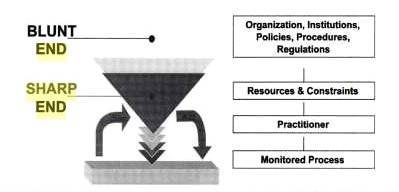Blunt and Sharp End
The next concept is that of blunt and sharp end. The blunt end usually encompasses
parts of the process farther away from the action itself – the environment in which
healthcare is delivered. Regulators, accreditors, administrators and designers function at
the blunt end. The blunt end influences the systems in which practitioners work. Direct
caregivers are considered the sharp end in the system because they are the direct
interface with the patient. Combined with the Swiss Cheese modes, it is easy to see that
when an error occurs, it is “visible” where the final error occurred, but all of the other
systems, departments and other factors are not easily recognized. This point will be
important to remember during the error analysis since multiple reasons or causes
usually contribute to an error. The blunt end in a system may either be a barrier or an
enabler for caregivers depending on how policies and procedures are designed.
For example, if a medication error occurs, it may be easy to blame the single nurse.
What is not readily apparent are factors that may have contributed to the error, such as
the medication delivery being late; or delivered to the wrong unit, or a policy that required
purchase of medications that were cheaper but look alike. Other “blunt ends” contribute
to potential errors but are only noticed when made at the “sharp end.”




